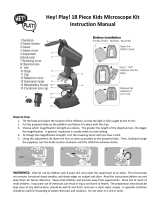Page is loading ...

The Professor by Ken-A-Vision
Instruction Manual
ESH101
ESH111

2
Thank you for purchasing The Professor by Ken-A-Vision.
Welcome to the world of microscopy. Here are a few things to get you
started. First, be sure the following items are included with your unit:
The Professor Microscope
Box of slides - (5) blank and (5) prepared
(3) AA batteries
THE PARTS OF A MICROSCOPE
1. Eyepiece: One 10x lens that you use to look through.
2. Arm: Supports the tube and connects to the base.
3. Nosepiece: This is the part that holds the objective lenses and
rotates to change the magnification.
4. Objective Lenses: The Professor Microscope consists of 3
objective lenses; 4x, 10x, and 40x. When combined with the 10x
eyepiece lens we get total magnifications of 40x (4 x times 10x),
100x, and 400x. The shortest lens is the lowest magnification,
and the longest lens has the greatest magnification.
5. Diaphragm: This is a rotating disk under the stage that has
different sized holes to vary the amount of light you want
projected upward into the slide.
6. Stage: The flat platform where you place your slides. The metal
clips hold your slide in place.
7. Illuminator: The light source is battery operated with 3 AA
batteries.
8. Focus Knob: Use this knob located on each side of The Professor
Microscope to focus the image of your specimen or slide.
9. Base: The bottom of the microscope that is used for support. The
Professor Microscope has a double switch on the front of the
microscope. Depressing the right side switch controls the bottom
illuminator (sub-stage light), providing light through the
condenser for a standard microscope slide. Depressing the left
side switch turns on the above stage light for macro and opaque
objects. The center position of the switch is OFF.
1
2
3
4
5
6
7
8

3
Viewing specimens with The Professor Microscope is both fun and easy.
Follow the instructions below to learn more details.
Installing / Replacing Batteries
1. The batteries are located in the bottom of the base.
2. Turn The Professor Microscope upside down. Using a coin, insert
it into the slot located on one side of the bottom of The
Professor Microscope. Flip open the bottom.
3. Remove any used batteries.
4. Insert (3) new AA batteries in the +/- direction as indicated on The
Professor microscope.
5. Insert the base plate into the notches and push close.
How To Use Your Microscope
1. Remove The Professor Microscope from its storage location by
grabbing the arm of The Professor Microscope with one hand
and place the other hand below the base.
2. Put a slide or specimen under the clips on the stage.
3. To view through the eyepiece lens, close one eye and look
through the eyepiece with the other. Now focus your microscope.
4. When your slide is in focus at the 4x objective lens, the other two
lenses will only need a small turn to bring into clear focus.
5. Adjust the amount of light by using the disc diaphragm. Turn until
you have the amount of light you want on your specimen.
6. Don't forget to turn on your microscope.
7. When using a glass slide put a plastic slide underneath the glass
slide.
Focusing
The proper way to focus a microscope is to turn the nosepiece to the
lowest power objective lens (4x). Next turn the focus knob to raise the
stage up until it stops. Then look through the eyepiece lens and focus
downward until the image is clear.
Changing Magnification
Choose the magnification by rotating the nosepiece, see drawing for
location, on the microscope until you hear a click. The next objective lens
should be in place. You may need to focus to adjust to the different
magnification.

5615 Raytown Road • Kansas City, MO 64133 U.S.A.
Tel.: 816-353-4787 • Fax: 816-358-5072
email: info@ken-a-vision.com • www.ken-a-vision.com
INS-SCESH
Taking Care of your Microscope
1. The Professor Microscope is a precision instrument, treat it with
care. When working with The Professor Microscope be sure it is
directly in front of you and any notes you take are set beside The
Professor Microscope. This method of viewing will limit the
chance of accidentally knocking the microscope off the table.
2. When the objective lenses or eyepiece are dirty, the image will
not be very clear and sharp. To clean, use lens paper and
distilled water and rub the lens and/or eyepiece softly. Never rub
the lens when it is dry. (This can cause static charge that will
attract dirt.)
Technical Specifications for Model No. ESH101 The Professor by
Ken-A-Vision Microscope
For the technical specifications on The Professor by Ken-A-Vision,
visit the Ken-A-Vision Web site, www.ken-a-vision.com /ESH101.asp
Accessories
If you are interested in purchasing accessories or replacement parts
for The Professor by Ken-A-Vision, visit the Ken-A-Vision Web site,
http://store.kenavision.com/catalog/ or contact your local Ken-A-Vision
Dealer.
/





